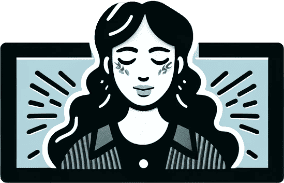Why do I feel sad in Winter?

Have you ever noticed that the colder months make you feel heavier, sadder, or more tired than usual? If you’ve been asking yourself, “Why do I feel sad in winter?” you’re not alone. Many people feel down when the days get shorter and colder. This sadness may be due to Seasonal Affective Disorder (SAD), a form of depression that usually happens in the fall and winter months.
In this article, we’ll explain what SAD is, why it happens, and how to recognize it in yourself or someone else. We’ll also cover ways to prevent it or recover from it if you’re already feeling its effects. Winter doesn’t have to be a season of gloom. With the right tools, you can brighten your days, even when it’s cold and dark outside.
Quick takes:
- SAD is a type of depression that usually shows up in fall and winter due to shorter daylight hours.
- It’s common in areas far from the equator, where winter days are much shorter, like the northern U.S., Canada, and northern Europe.
- You may have SAD if you feel persistently down, fatigued, or uninterested in things you normally enjoy when winter arrives.
- You can try avoiding SAD by getting more sunlight, staying active, and sticking to a regular sleep schedule.
- Light therapy, exercise, and professional help can all be part of recovery if SAD has already started affecting you.
What is Seasonal Affective Disorder (SAD)?
Seasonal Affective Disorder is a recurring type of depression that typically begins in the fall and lasts through winter. While the exact cause isn’t fully understood, it’s believed that shorter days and less sunlight can disrupt your internal body clock, affecting your mood and energy levels.
Without enough sunlight, your body may struggle to regulate important hormones like melatonin and serotonin, which control your sleep and mood. As a result, many people with SAD experience a drop in energy, feelings of hopelessness, and difficulty concentrating. Symptoms usually improve in the spring and summer when sunlight increases.
Where is Seasonal Affective Disorder most common?

SAD is most common in regions farther from the equator, where the winter months bring shorter daylight hours. Countries in the northern hemisphere, like the United States, Canada, and parts of Europe, tend to have higher instances of SAD.
If you live in a place where you leave for work or school in the dark and come home in the dark, that could explain why you’re wondering, “Why do I feel sad in winter?” A lack of sunlight can have a big impact on your mood and energy.
Who is most affected by Seasonal Affective Disorder?
Anyone can experience SAD, but certain groups of people are more likely to be affected:
- Women: Women are more often diagnosed with SAD than men, though the reasons for this aren’t fully understood.
- Young adults: SAD is most commonly diagnosed in people between the ages of 18 and 30, although it can develop at any age.
- Those with a family history of depression: If you have relatives who struggle with depression or other mood disorders, you might be more susceptible.
- People with pre-existing mental health conditions: Those with depression or bipolar disorder may notice their symptoms worsen during the winter months.
How to know if you are experiencing Seasonal Affective Disorder
If you’ve been feeling down, tired, or uninterested in things you usually enjoy during the winter months, it could be more than just the “winter blues.” You may be experiencing SAD. Here are some signs to watch for:
- Persistent sadness: Feeling sad or hopeless most of the day, nearly every day.
- Fatigue: Even after getting enough sleep, you still feel tired and drained.
- Loss of interest: Things you used to enjoy, like hobbies or socializing, no longer seem appealing.
- Appetite changes: You might notice that you’re eating more than usual, especially craving carbs and sweets, or that you’ve lost your appetite altogether.
- Difficulty concentrating: Simple tasks feel overwhelming or it’s hard to focus.
If these symptoms last for more than a couple of weeks, it may be time to consider talking to a healthcare provider.
How to know if someone you care about has Seasonal Affective Disorder
Sometimes it’s easier to recognize SAD in others than in ourselves. If someone close to you seems less like themselves during the winter, they might be struggling with SAD. Here’s what to look for:
- Uncharacteristic mood changes: Are they more irritable, withdrawn, or sad than usual?
- Social withdrawal: They might be avoiding social activities or spending more time alone.
- Constant fatigue: They seem exhausted all the time, even after a full night’s rest.
- Changes in eating habits: Their appetite may have noticeably changed—either eating more or less than usual.
If you’re concerned, approach them with compassion and suggest they talk to someone about how they’re feeling. It could make a big difference.
How to prevent or recover from Seasonal Affective Disorder

Preventing SAD is possible, especially if you’ve experienced it before. Here are some ways to help keep your mood and energy up during the winter months:
- Get more sunlight: Try to spend time outside during daylight hours, even on cloudy days. If you can’t get outdoors, sit by a window that lets in natural light.
- Use light therapy: A light therapy box mimics natural sunlight and can help regulate your body’s internal clock. Using it for about 20-30 minutes each morning can prevent SAD symptoms from taking hold. NOTE: I used a light therapy box in my basement office and it made a world of difference in how I felt.
- Stay active: Physical activity, like walking or yoga, can naturally boost your serotonin levels, improving your mood and energy. Try to get moving daily, even if it’s just a short walk.
- Eat balanced meals: A healthy, balanced diet with whole grains, vegetables, and protein can help stabilize your energy levels throughout the day.
- Stick to a routine: Having a consistent sleep and daily routine can help your body adapt to the seasonal changes and maintain balance.
- Stay connected: Don’t isolate yourself—maintain your social connections with friends and family, even if it’s just a quick phone call. If you’re feeling down, don’t hesitate to talk to someone about it, whether it’s a friend, family member, or healthcare provider.
- Seek professional help: Cognitive-behavioral therapy (CBT) is highly effective for treating SAD. It helps you identify negative thought patterns and replace them with healthier ones. Your doctor might also recommend medication if it’s right for you.
Let’s wrap it up…
If winter makes you feel sad, sluggish, or unmotivated, you don’t have to go through it alone. Seasonal Affective Disorder is a common condition, especially in areas with long, dark winters, but with the right strategies, you can prevent it or recover from it. Light therapy, getting outside, sleeping regularly, exercise, and talking to a healthcare provider can all help you feel better during the colder months.
Don’t wait to take action. If you think SAD is affecting you, try out some of these tips, and reach out for help when needed. You deserve to feel good, no matter the season.
By taking action now, you can get back to feeling like yourself, even in the depths of winter. Keep in mind that seeking help early can make all the difference in how you experience the season.
Frequent questions about Seasonal Affective Disorder
More stuff about Seasonal Affective Disorder, from other places…
- National Institute of Mental Health – Seasonal Affective Disorder
- Mayo Clinic – Seasonal Affective Disorder
- How to treat seasonal depression
How do you feel during the winter months?
Let me know down below in a comment–do you think you generally experience SAD during the winter? What else do you know about seasonal affective disorder?


Leave a Reply